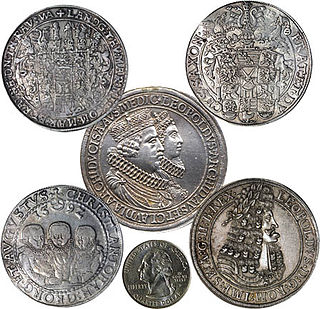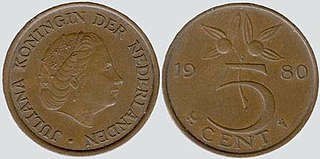
Guilder is the English translation of the Dutch and German gulden, originally shortened from Middle High German guldin pfenninc "gold penny". This was the term that became current in the southern and western parts of the Holy Roman Empire for the Fiorino d'oro. Hence, the name has often been interchangeable with florin.

A thaler is one of the large silver coins minted in the states and territories of the Holy Roman Empire and the Habsburg monarchy during the Early Modern period. A thaler size silver coin has a diameter of about 40 mm and a weight of about 25 to 30 grams. The word is shortened from Joachimsthaler, the original thaler coin minted in Joachimstal, Bohemia, from 1518.

The ducat coin was used as a trade coin in Europe from the later Middle Ages from the 13th to 19th centuries. Its most familiar version, the gold ducat or sequin containing around 3.5 grams of 98.6% fine gold, originated in Venice in 1284 and gained wide international acceptance over the centuries. Similarly named silver ducatons also existed. The gold ducat circulated along with the Florentine florin and preceded the modern British pound sterling and the United States dollar.

The Belgian franc was the currency of the Kingdom of Belgium from 1832 until 2002 when the Euro was introduced. It was subdivided into 100 subunits, each known as a centiem in Dutch, centime in French or a Centime in German.
The guilder or florin was the currency of the Netherlands from the 15th century until 2002, when it was replaced by the euro.

The stuiver[stœy.vər] was a coin used in the Netherlands, worth 1⁄20 Dutch Guilders. It was also minted on the Lower Rhine region and the Dutch colonies. The word can still refer to the 5 euro cent coin, which has almost exactly the same diameter and colour despite being over twice the value of the older coin.

The rijksdaalder was a Dutch coin first issued by the Republic of the Seven United Netherlands in the late 16th century during the Dutch Revolt which featured an armored half bust of William the Silent. It was the Dutch counterpart of the Reichsthaler of the Holy Roman Empire but weighed slightly less, at 29.03 g of 0.885 fine silver, reduced to 0.875 fine by the 17th century. Friesland, Gelderland, Holland, Kampen, Overijssel, Utrecht, West Friesland, Zeeland, and Zwolle minted armored half bust rijksdaalders until the end of the 17th century.
The coins of the South African pound were part of the physical form of South Africa's historical currency, the South African pound. Prior to the Union of 1910, various authorities issued their own pounds, some as independent entities. After the Union but before 1923, coins in circulation were mostly British, but the coins of Paul Kruger's South African Republic remained in circulation. In 1923, South Africa began to issue its own coins, adopting coins that were identical in size and value to those used in Great Britain: 12 pence (12d) = 1 shilling (1s), and 20s = 1 pound (£1). On 14 February 1961, the Union of South Africa adopted a decimal currency, replacing the pound with the Rand.

The Swiss franc has been the currency of Liechtenstein since 1920. The Swiss franc is legal tender since Liechtenstein is in a customs and monetary union with Switzerland. The 1980 treaty between Switzerland and Liechtenstein allows Liechtenstein to mint limited amounts of Swiss francs with a Liechtenstein inscription, but only in the form of commemorative coins, and they are not allowed to issue banknotes.

The Dutch Five guilder coin was the highest-denomination coin in the Netherlands from its introduction in 1988 until the adoption of the euro in 2002. Its nominal value was ƒ 5,-.
The One guilder coin was a coin struck in the Kingdom of the Netherlands between 1818 and 2001. It remained in circulation until 2002 when the guilder currency was replaced by the euro. No guilder coins were minted in the German occupation of the Netherlands in World War II.

The zinc 5-cent coin was minted in the Netherlands between 1941 and 1943 during World War II. It was worth 1/20, or .05, of the guilder, and designed by Nico de Haas, a Dutch national-socialist.
The half-cent coin was a Dutch coin used from 1818 to 1940. It was the smallest-denomination coin of the decimal Dutch guilder until its withdrawal from circulation after the German occupation of the Netherlands in 1940. It was nicknamed "Halfje", similar to the Kwartje.

A dubbeltje is a small former Dutch coin, originally made of silver, with a value of a tenth of a Dutch guilder. The 10-euro-cent coin is currently also called a dubbeltje in the Netherlands.

The Five cent coin was a coin struck in the Kingdom of the Netherlands between 1818 and 2001. Twenty stuivers equalled a Dutch Guilder.
The Half guilder coin was a silver coin struck in the Kingdom of the Netherlands between 1818 and 1930. The obverse featured a portrait of the Dutch reigning King or Queen. On the reverse was a crowned Dutch coat of arms between the value. All coins were minted in Utrecht except the year 1829 and 1830 that were minted in Brussels.

The one-cent coin was a coin struck in the Kingdom of the Netherlands between 1817 and 1980. The coin was worth 1 cent or 1⁄100 of a Dutch guilder.
The Three guilder coin was a silver coin struck in the Kingdom of the Netherlands between 1817 and 1832.

The Indian 10-rupee coin is a denomination of the Indian rupee. The ₹10 coin is the second highest-denomination coin minted in India since its introduction in 2005. The present ₹10 coin in circulation is from the 2019 design. However, the previous ₹10 coins minted before 2019 are also legal tender in India. All ₹10 coins containing with and without the rupee currency sign are legal tender, as stated by the Reserve Bank of India. Along with the standard designs, there are 4 different designs for this denomination and this is used alongside the 10 rupee banknote.

The Philippine fifty-centavo coin (50¢) was a denomination of Philippine currency. It was minted for the Philippines from 1864 to 1994 and was demonetized in 1998.


















